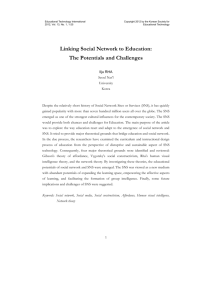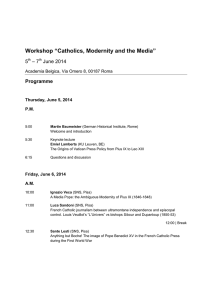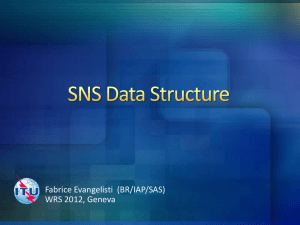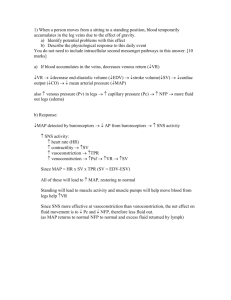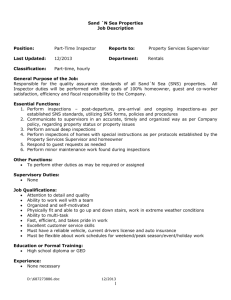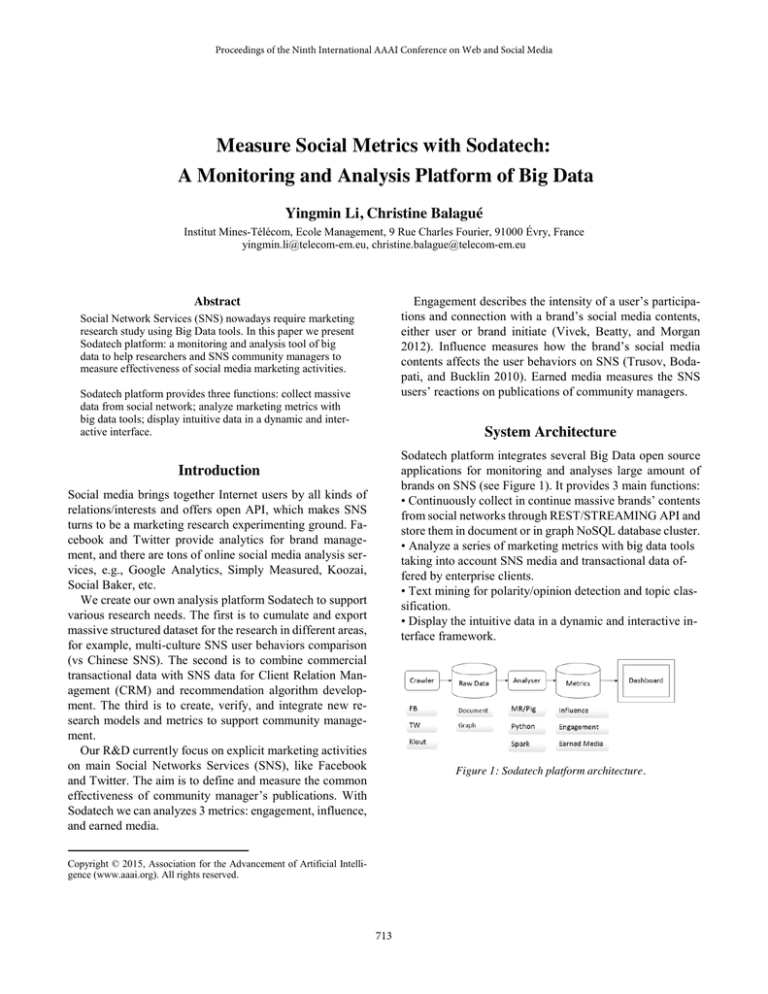
Proceedings of the Ninth International AAAI Conference on Web and Social Media
Measure Social Metrics with Sodatech:
A Monitoring and Analysis Platform of Big Data
Yingmin Li, Christine Balagué
Institut Mines-Télécom, Ecole Management, 9 Rue Charles Fourier, 91000 Évry, France
yingmin.li@telecom-em.eu, christine.balague@telecom-em.eu
Engagement describes the intensity of a user’s participations and connection with a brand’s social media contents,
either user or brand initiate (Vivek, Beatty, and Morgan
2012). Influence measures how the brand’s social media
contents affects the user behaviors on SNS (Trusov, Bodapati, and Bucklin 2010). Earned media measures the SNS
users’ reactions on publications of community managers.
Abstract
Social Network Services (SNS) nowadays require marketing
research study using Big Data tools. In this paper we present
Sodatech platform: a monitoring and analysis tool of big
data to help researchers and SNS community managers to
measure effectiveness of social media marketing activities.
Sodatech platform provides three functions: collect massive
data from social network; analyze marketing metrics with
big data tools; display intuitive data in a dynamic and interactive interface.
System Architecture
Sodatech platform integrates several Big Data open source
applications for monitoring and analyses large amount of
brands on SNS (see Figure 1). It provides 3 main functions:
• Continuously collect in continue massive brands’ contents
from social networks through REST/STREAMING API and
store them in document or in graph NoSQL database cluster.
• Analyze a series of marketing metrics with big data tools
taking into account SNS media and transactional data offered by enterprise clients.
• Text mining for polarity/opinion detection and topic classification.
• Display the intuitive data in a dynamic and interactive interface framework.
Introduction
Social media brings together Internet users by all kinds of
relations/interests and offers open API, which makes SNS
turns to be a marketing research experimenting ground. Facebook and Twitter provide analytics for brand management, and there are tons of online social media analysis services, e.g., Google Analytics, Simply Measured, Koozai,
Social Baker, etc.
We create our own analysis platform Sodatech to support
various research needs. The first is to cumulate and export
massive structured dataset for the research in different areas,
for example, multi-culture SNS user behaviors comparison
(vs Chinese SNS). The second is to combine commercial
transactional data with SNS data for Client Relation Management (CRM) and recommendation algorithm development. The third is to create, verify, and integrate new research models and metrics to support community management.
Our R&D currently focus on explicit marketing activities
on main Social Networks Services (SNS), like Facebook
and Twitter. The aim is to define and measure the common
effectiveness of community manager’s publications. With
Sodatech we can analyzes 3 metrics: engagement, influence,
and earned media.
Figure 1: Sodatech platform architecture.
Copyright © 2015, Association for the Advancement of Artificial Intelligence (www.aaai.org). All rights reserved.
713
Social Metrics
Different SNS allow similar social actions (paired in Table
1), which allow us to easily adapt metrics equations for each
SNS. Variable Bi,u(t) defines the user (u)’s engagement
contribution ( number sum) of each action on date (t). Variable Ri,u,p(t) defines the content (p)’s influence contribution of each u’s action on date (t). Variable Pm is the number
of content created by community manager; and M is the
number of reactive media contents.
Facebook
Post
Comment
Like
Share
Twitter Engagement(t) Influence(t)
Tweet
B1,u(t)
R1,u,p(t)
Reply
B2,u(t)
R2,u,p(t)
Retweet
B4,u(t)
R3,u,p(t)
B3,u(t)
R4,u,p(t)
Figure 3: Brand’s actions and reactions on timemline.
EM
Pm
M
0
0
We also compare the part (%) of publications of absolute
top 20 engagement users, relative top 20% engagement users, absolute top 20 influent users, and relative top 20% influent users, to test if it fits Pareto principle on SNS: the
20% top engaged users publish about 80% contents.
Table 1: Social action pairs.
More specifically, the engagement E of user (u) is the integration on date (t) of the weighted (α) sum of
scores Bi,u(t) attenuated by date. The influence I of content p on each user u is the integration on t of the weighted
(β) sum of scores Ri,u,p(t) attenuated by date. The earned
media EM measures the average number of media contents
aroused by social media contents
Future work
As the future work, Sodatech will cumulate dataset, develop crawlers for more SNS, and more metrics (in Figure
4).
Visualization interface
Sodatech aims to offer intuitive insights on effectiveness of
community management. One can collect the own social
brands and all their competitor brands to compare the engagement, influence, and earned media scores. Figure 2
and 3 detail the statistics and bar chart on timeline of a
brand’s actions of community management and reactions
of users. In figure 3, we can clearly see the target of community manager is to arouse bigger blue part by creating
relatively smaller orange part.
Figure 4: Current (inner) and future (outer) applications and
functions of Sodatech platform.
References
Vivek S. D., Beatty S. E. & Morgan, R. M. 2012. Customer engagement: Exploring customer relationships beyond purchase,
Journal of Marketing Theory and Practice, 20, 2, 127-145.
Trusov M., Bodapati A. and Bucklin R. E. 2010, Determining Influential Users in Internet Social Networks, Journal of Marketing
Research, Vol. 47 (4), 643-658.
Figure 2: Brand’s actions and reactions statistics.
714




